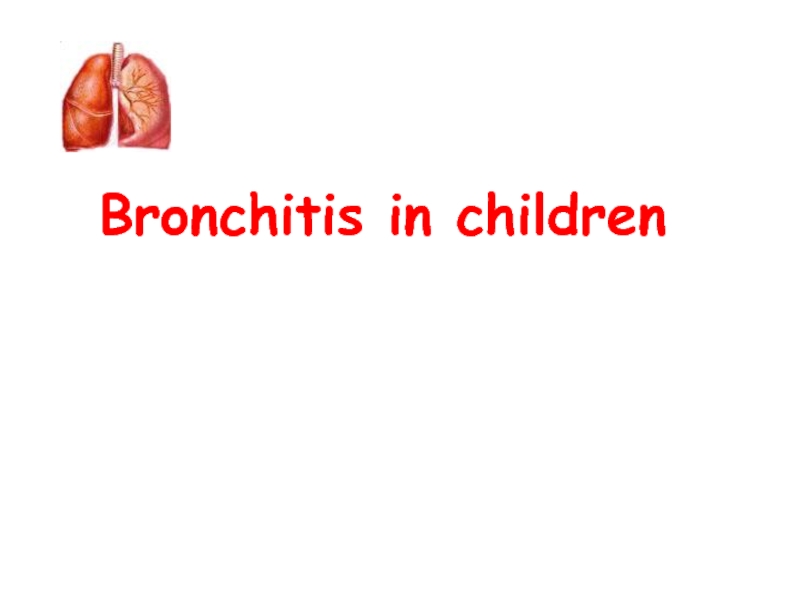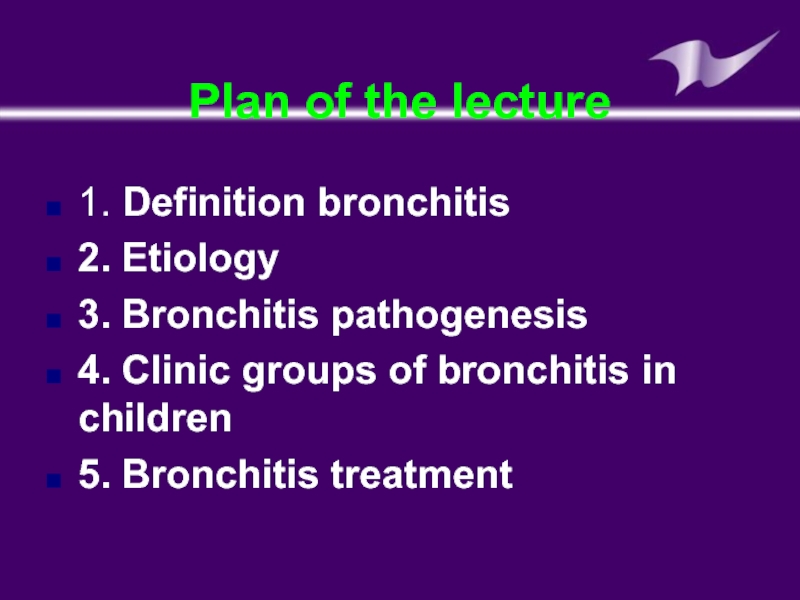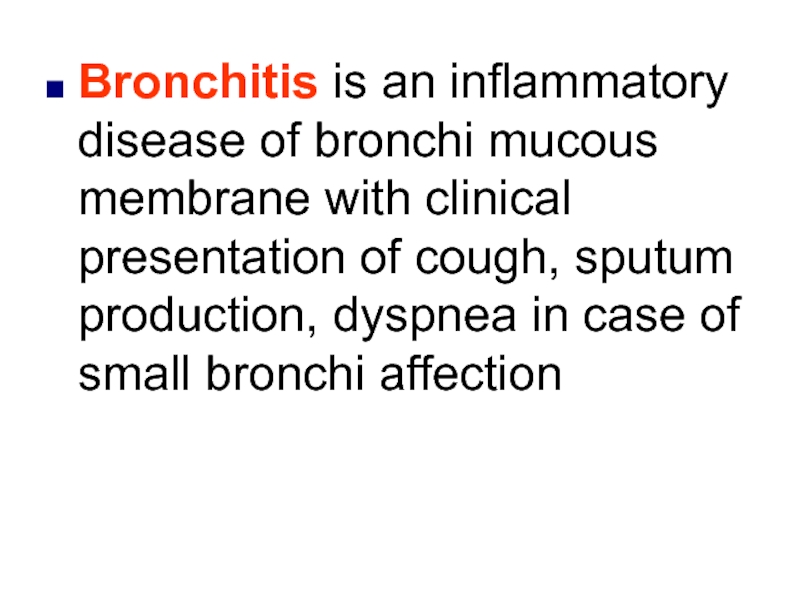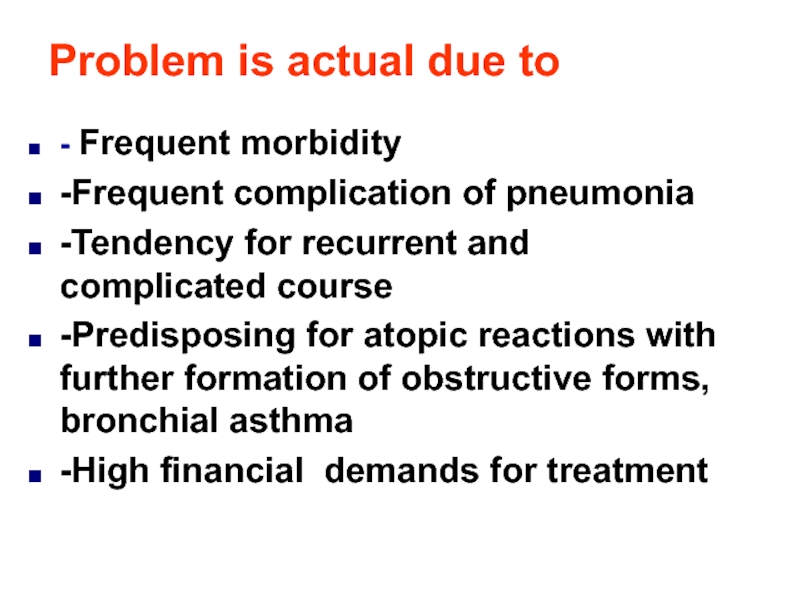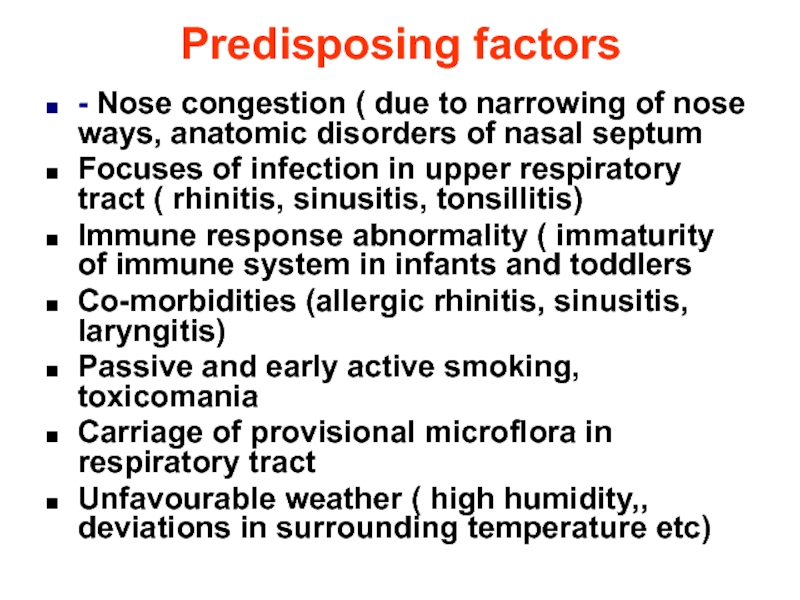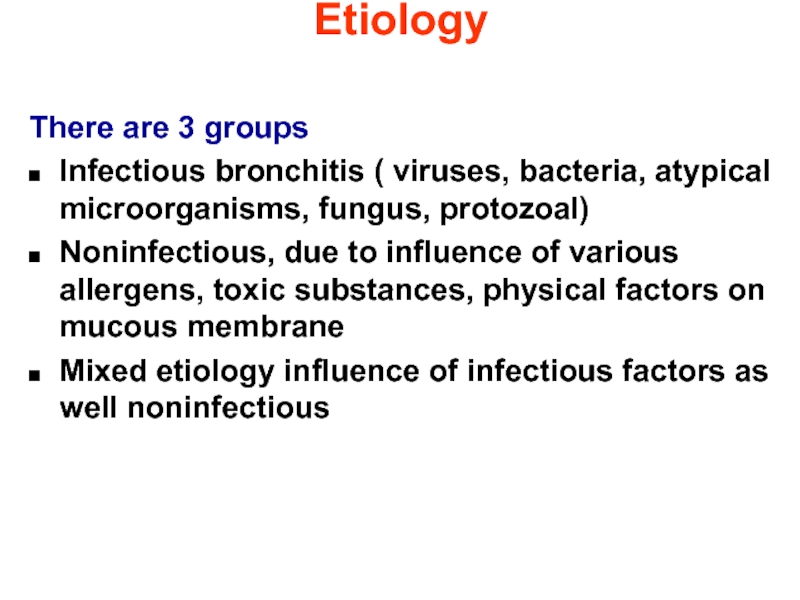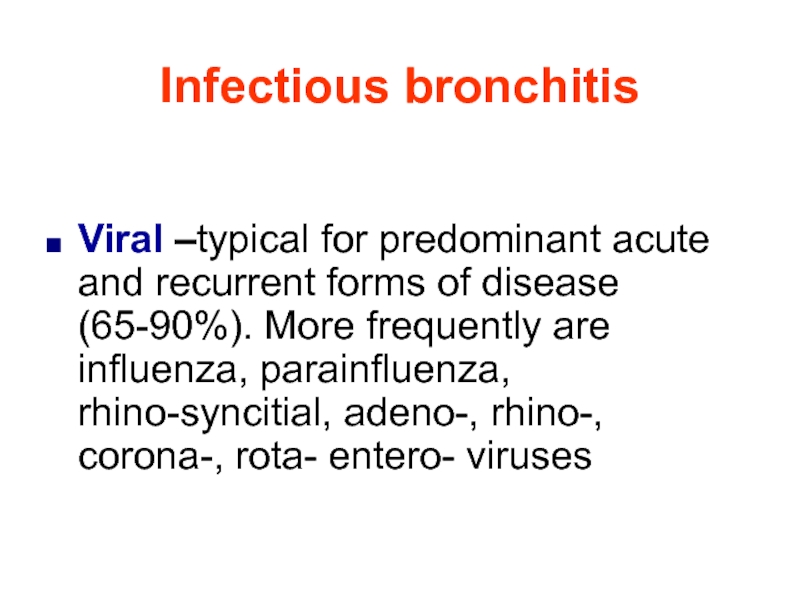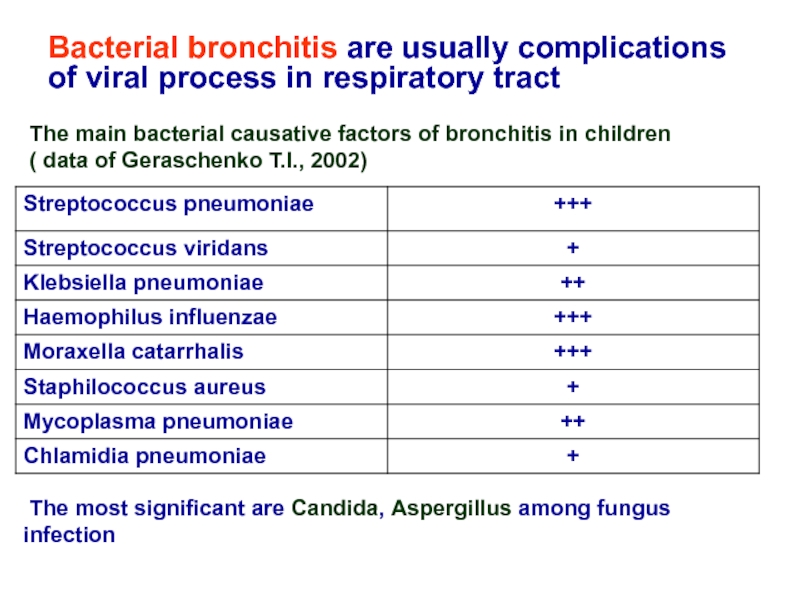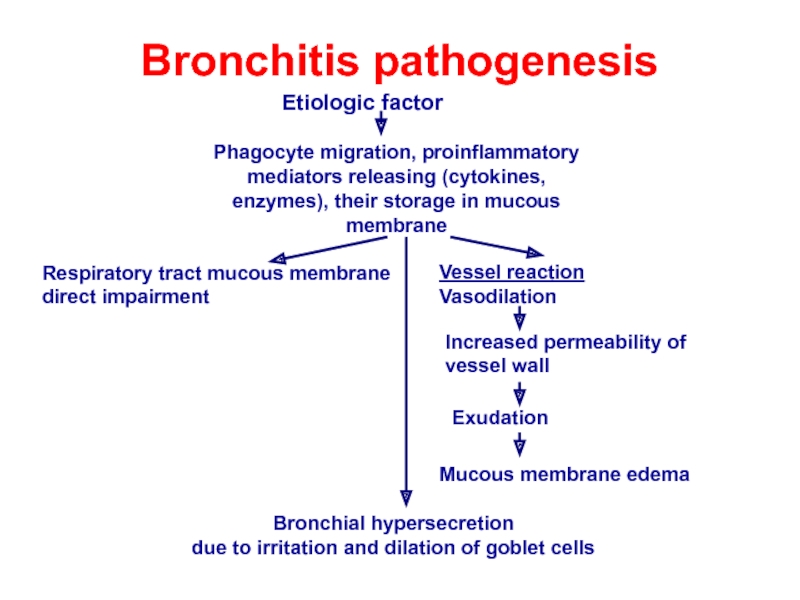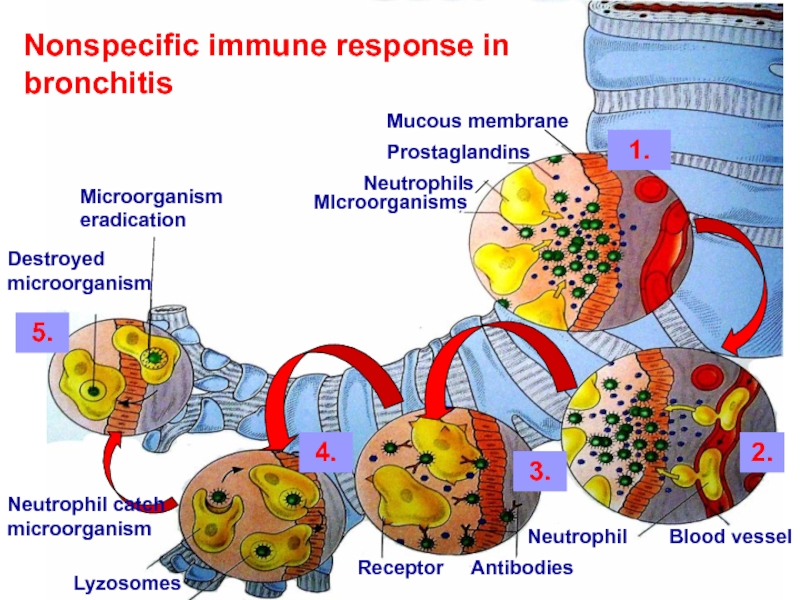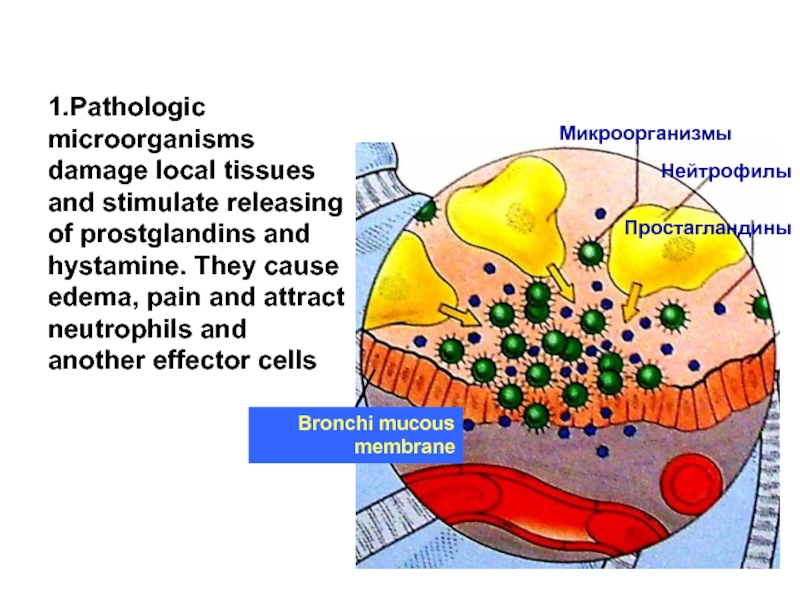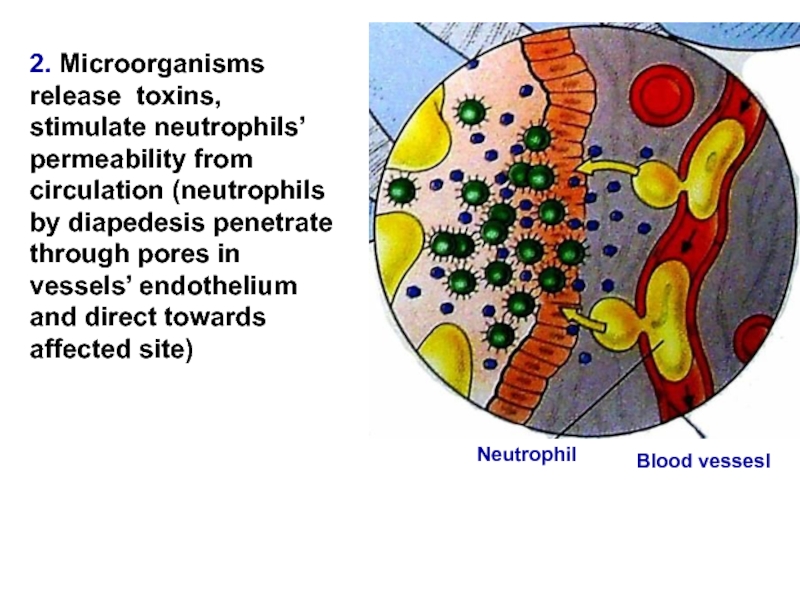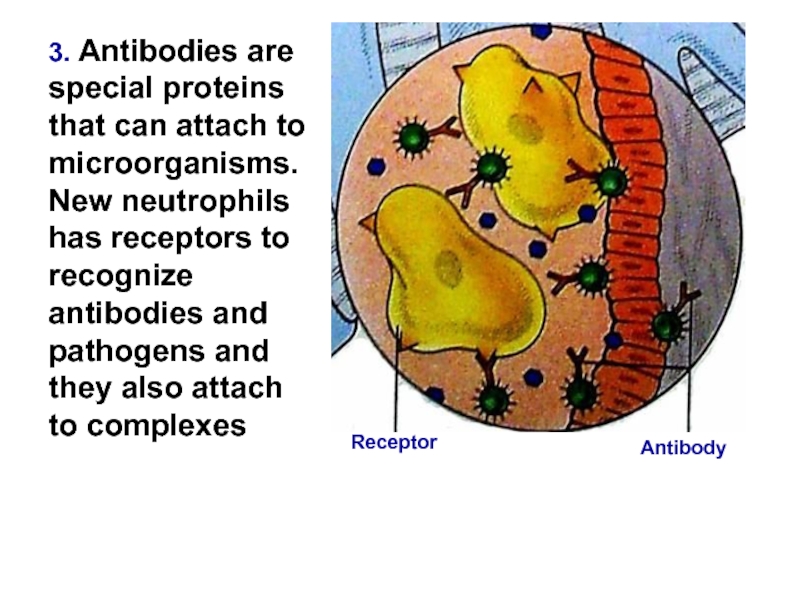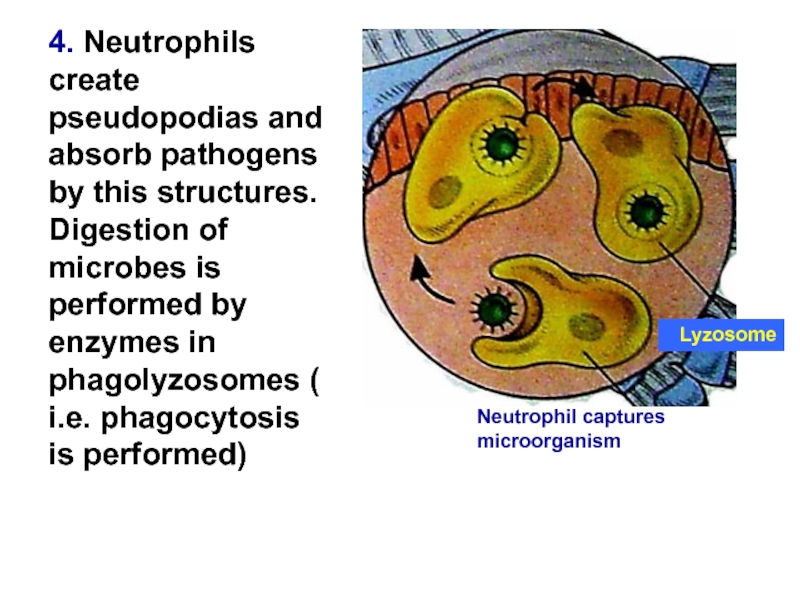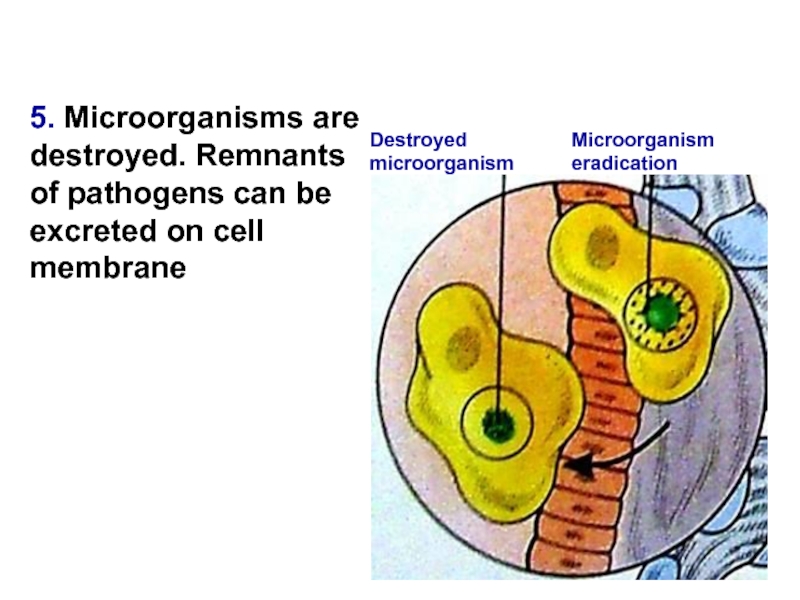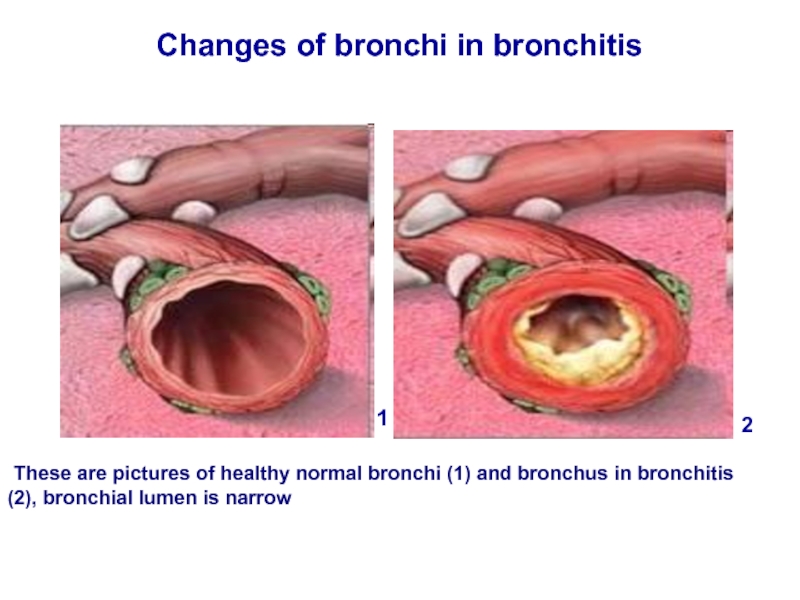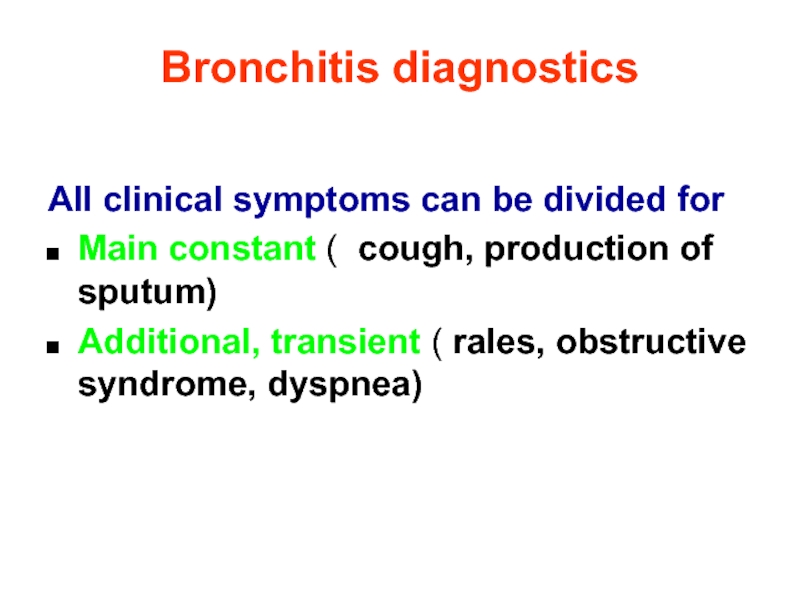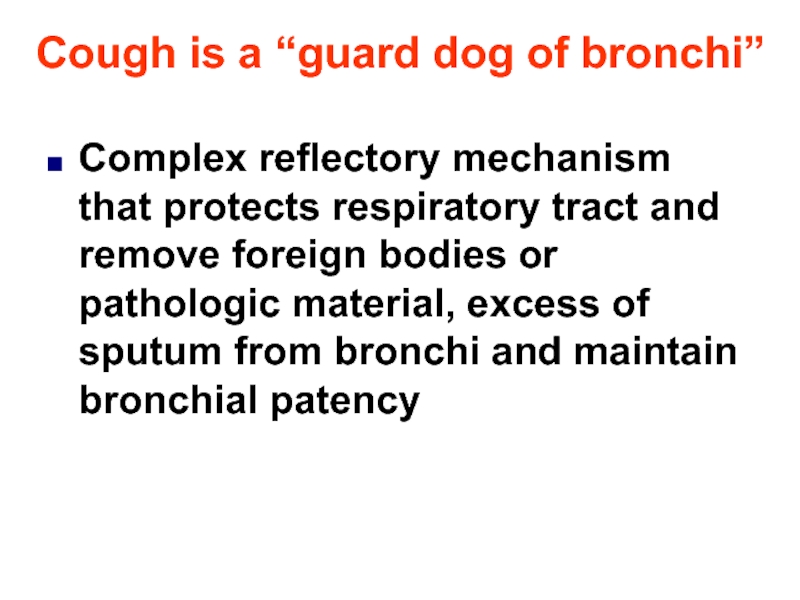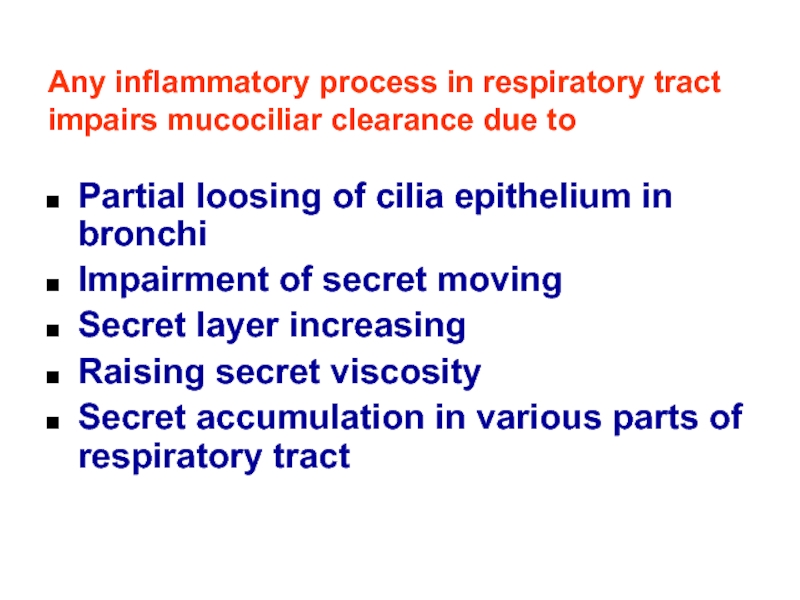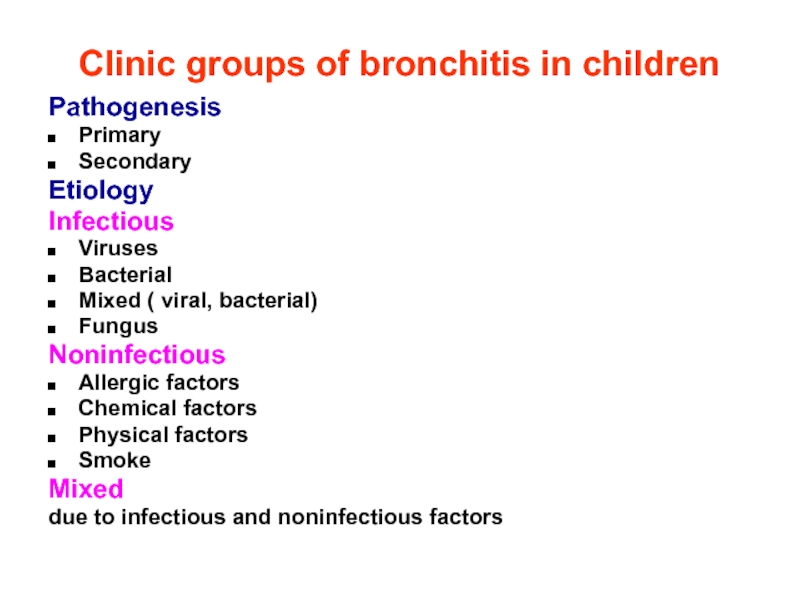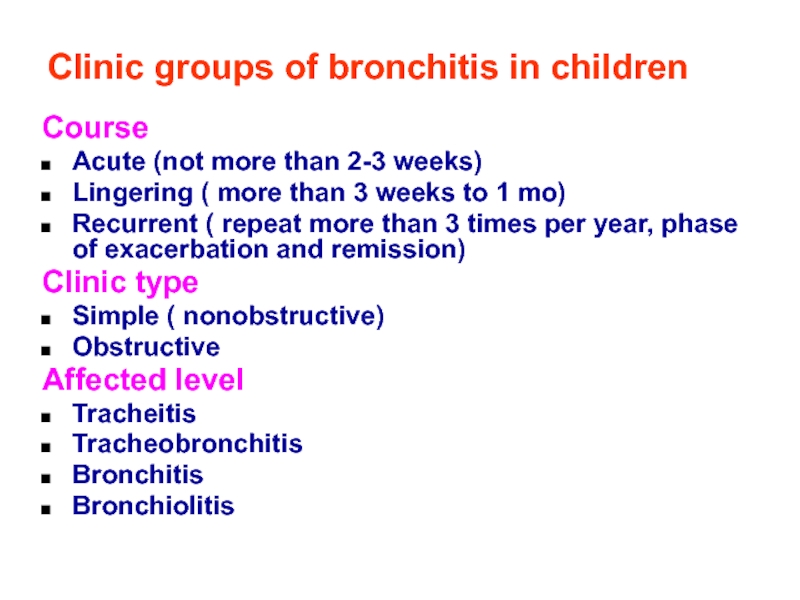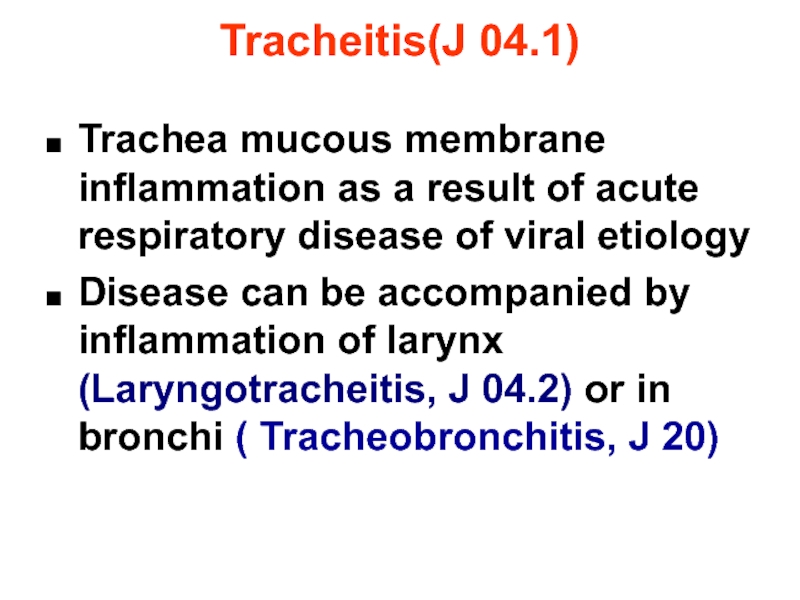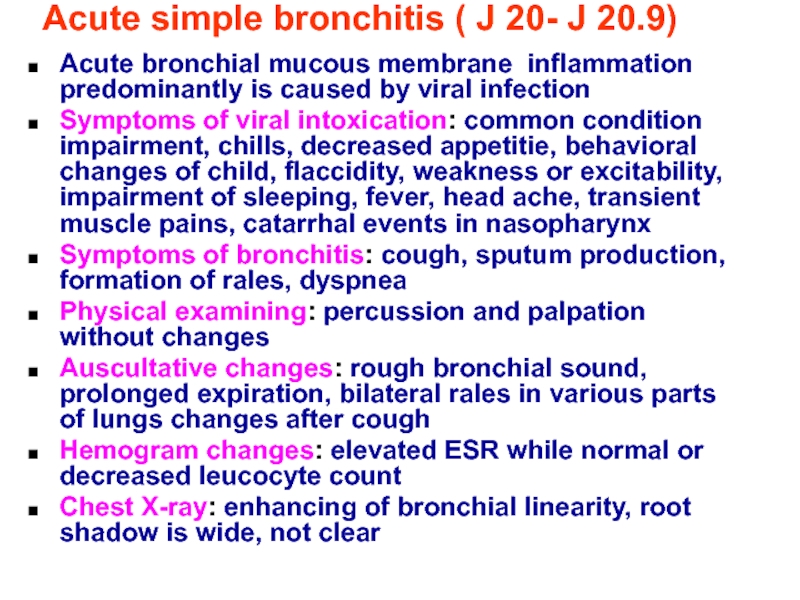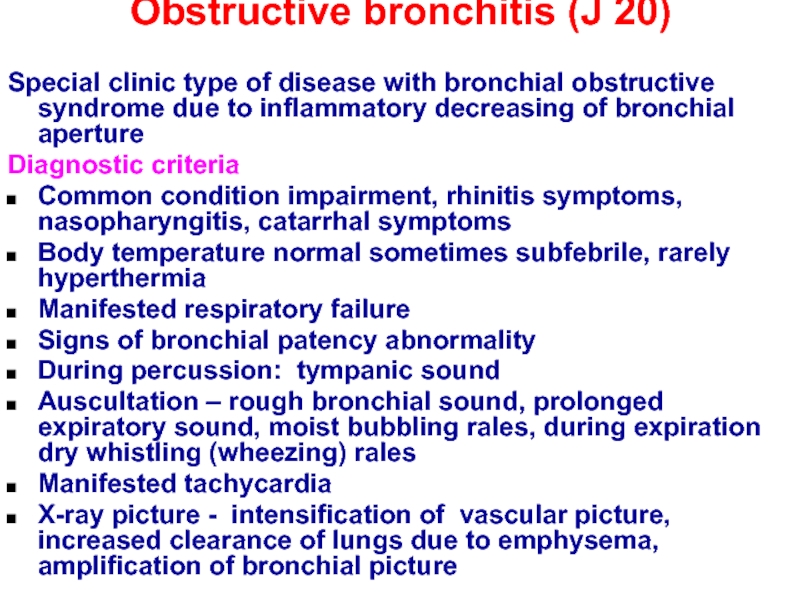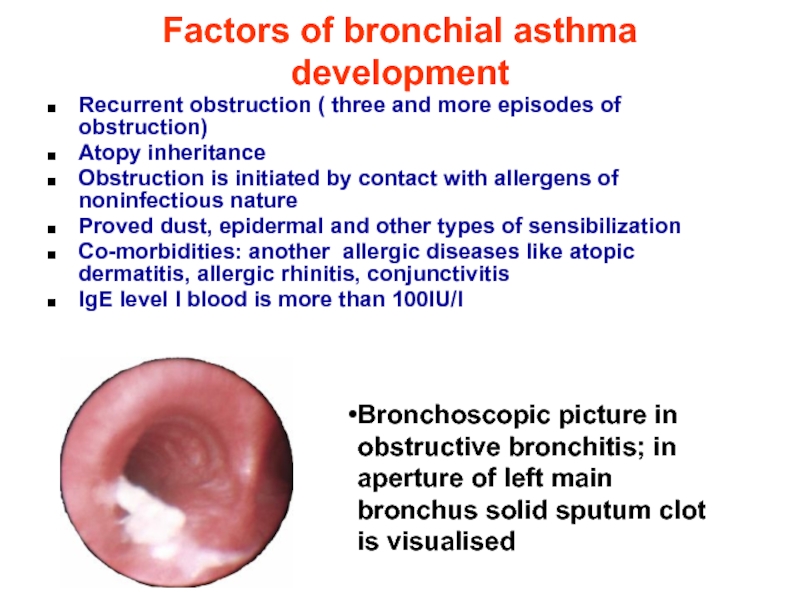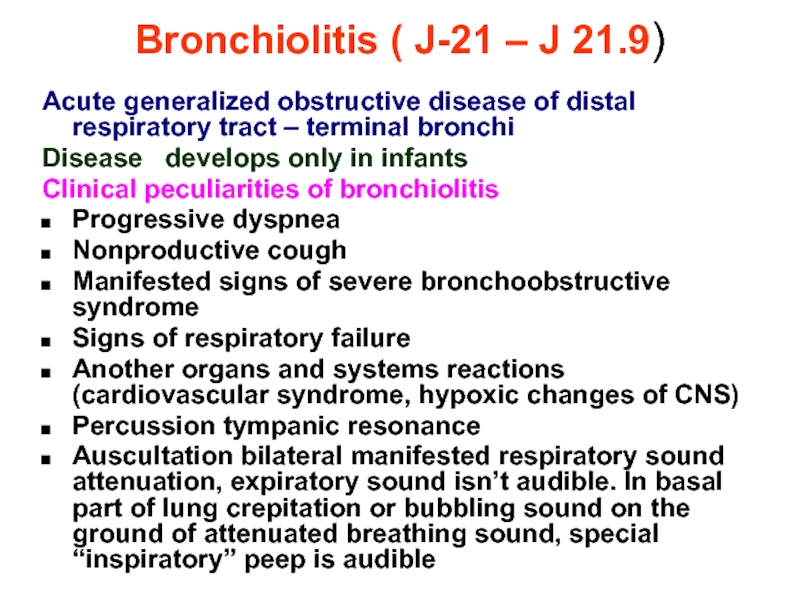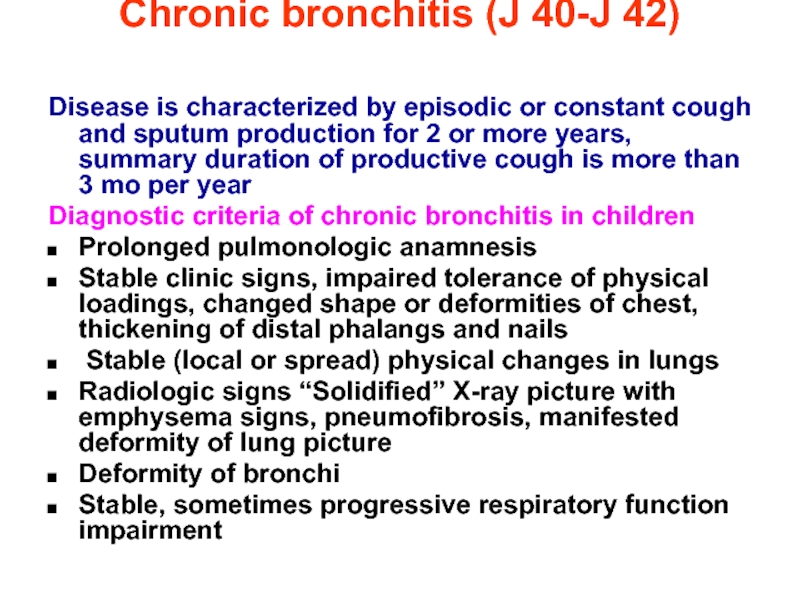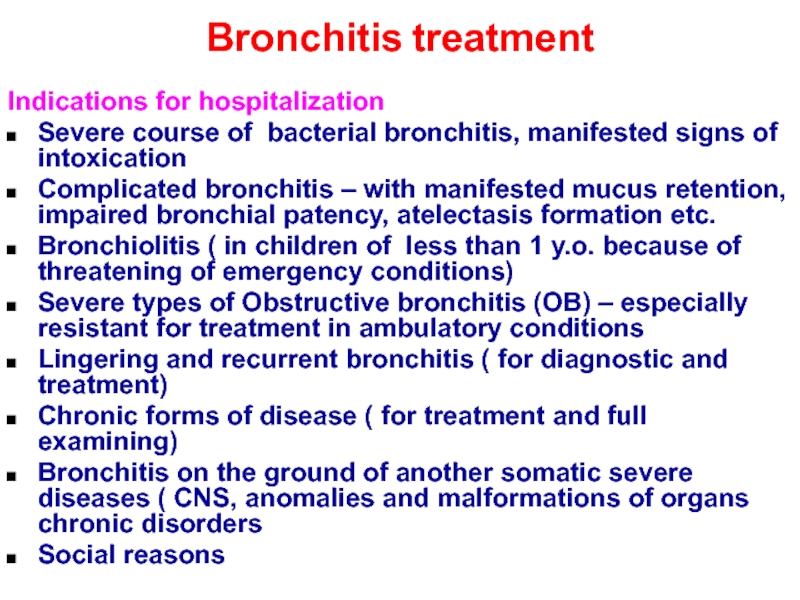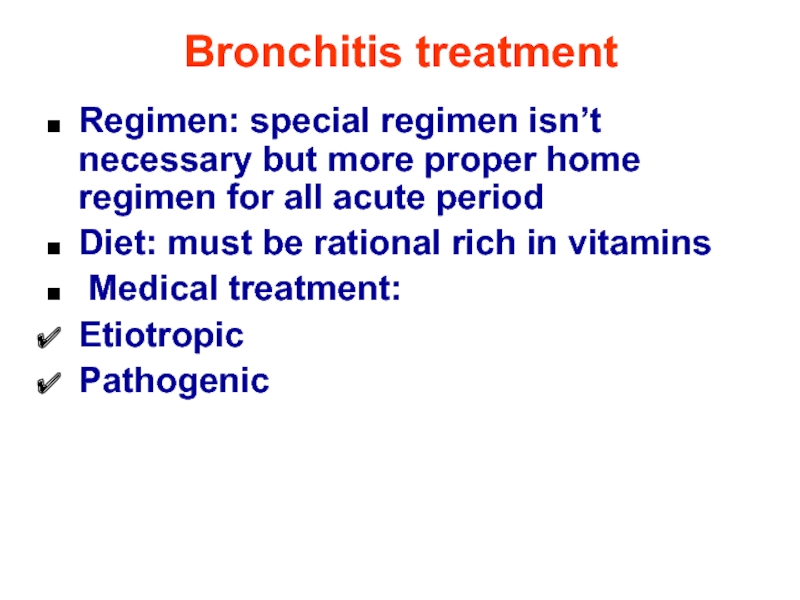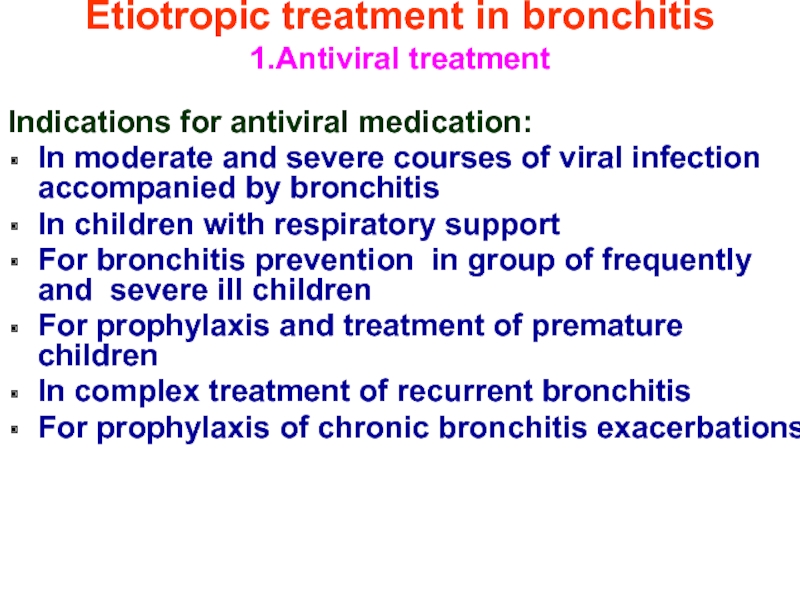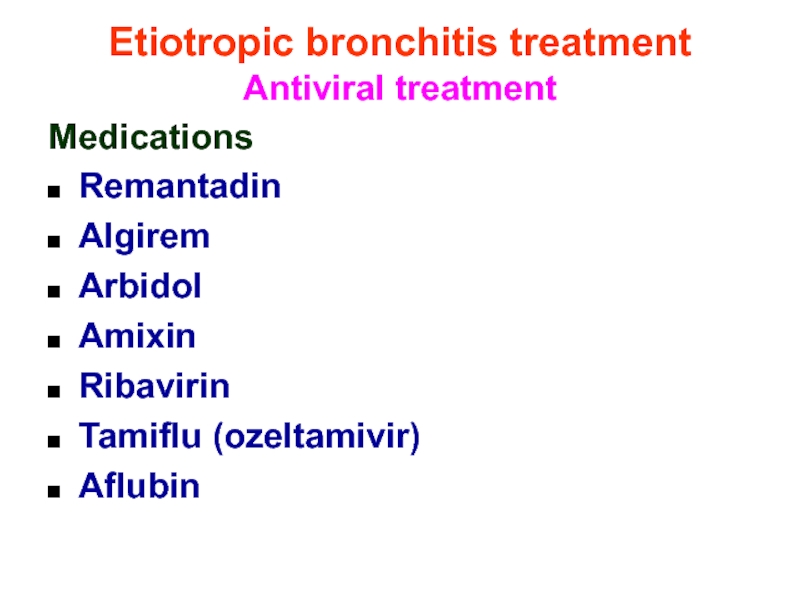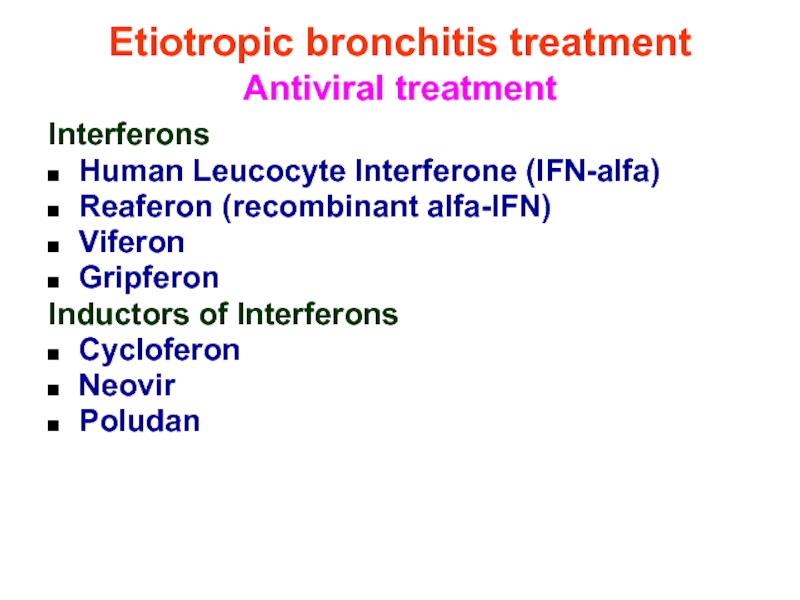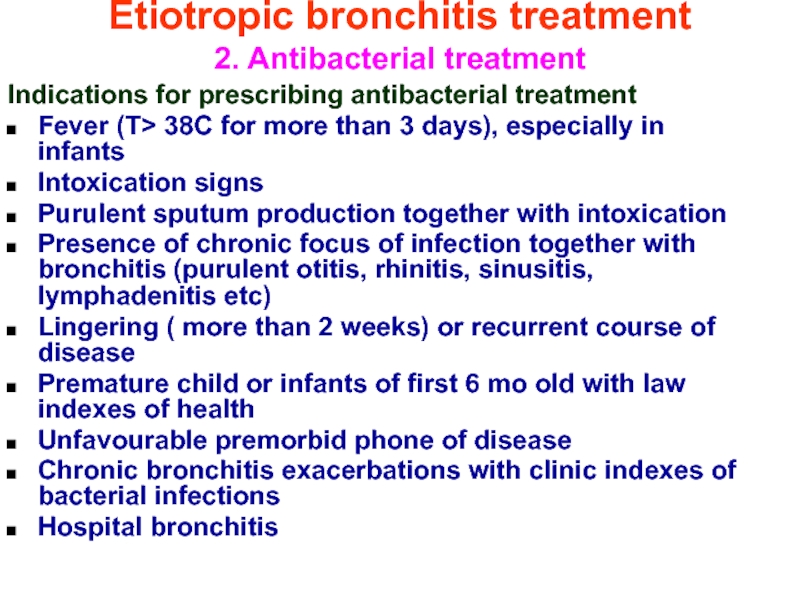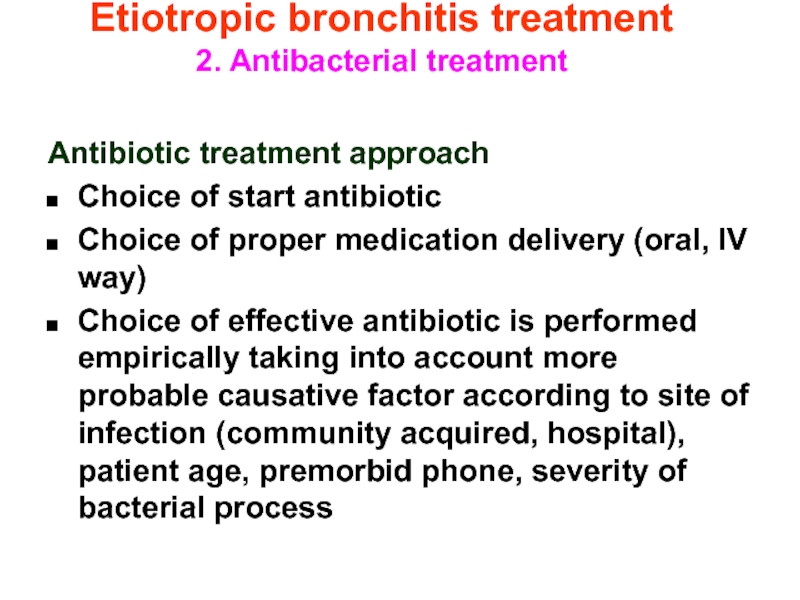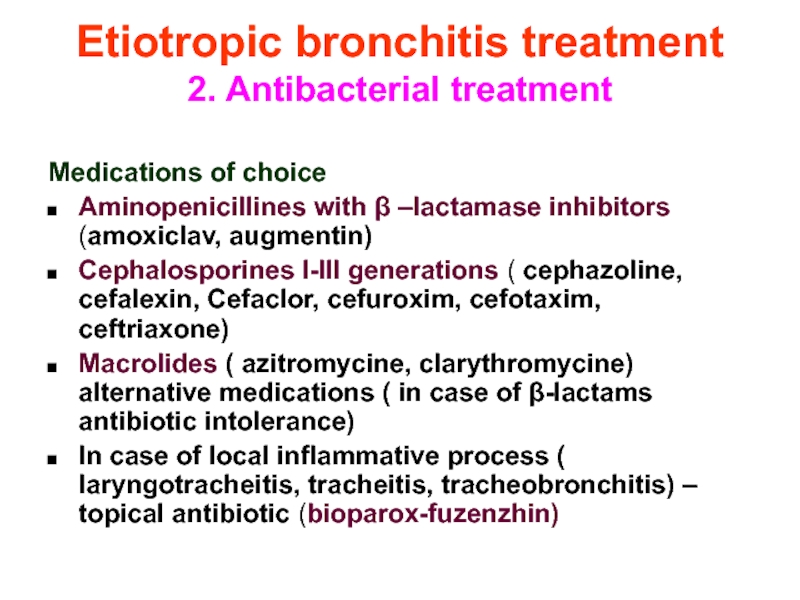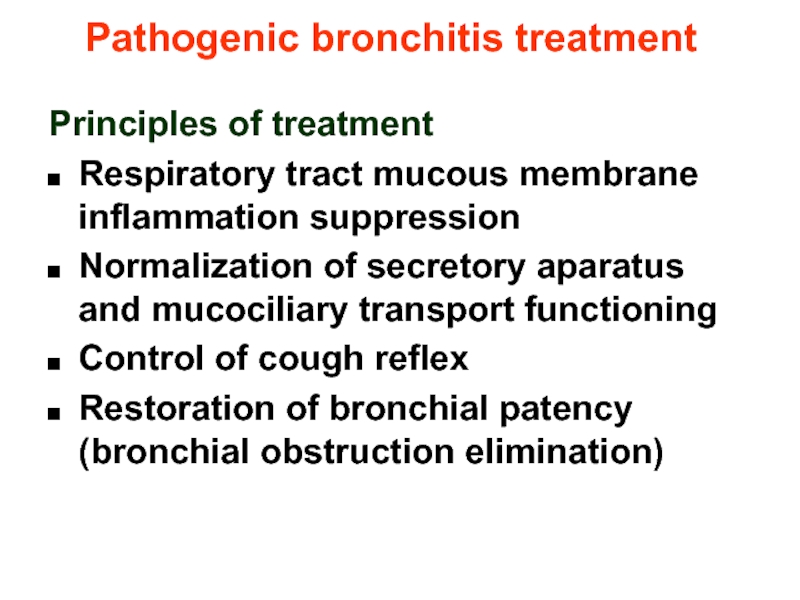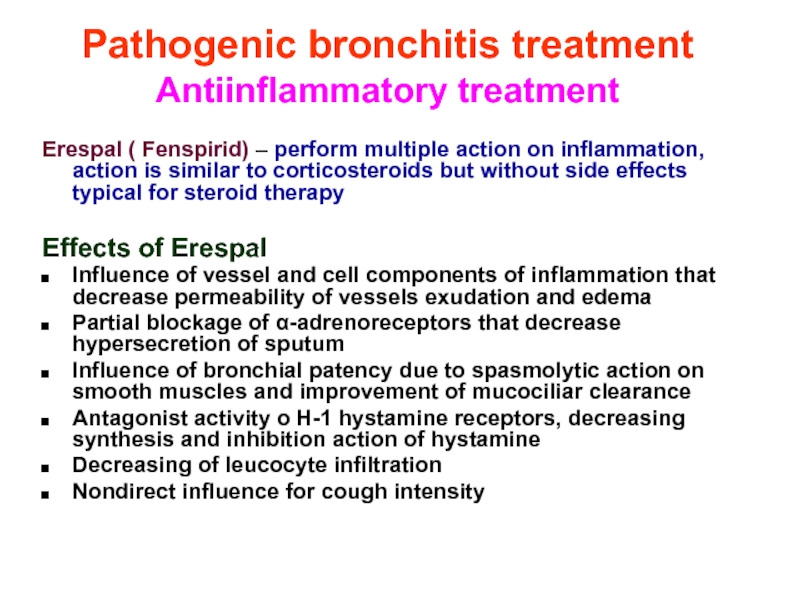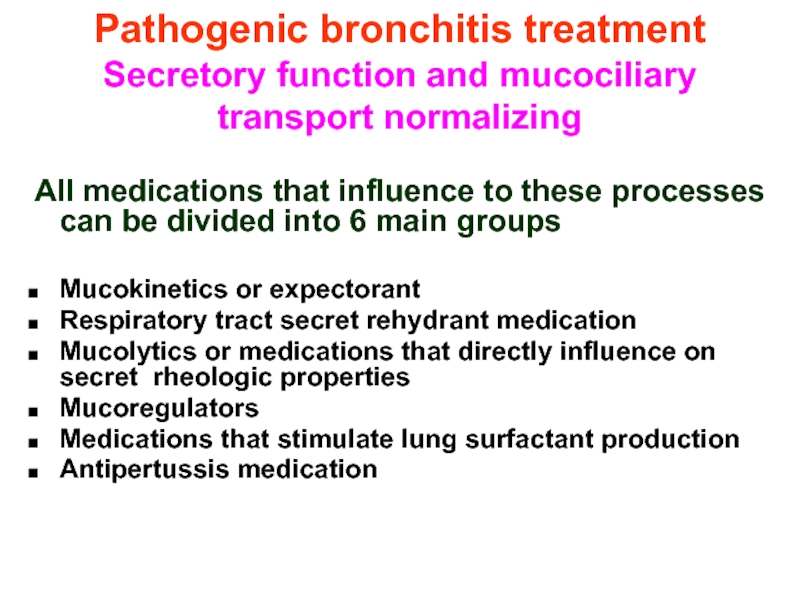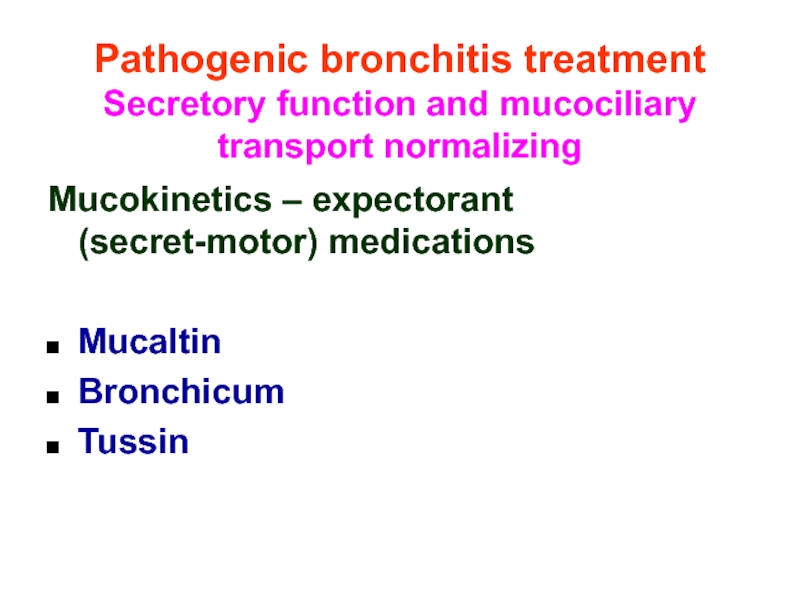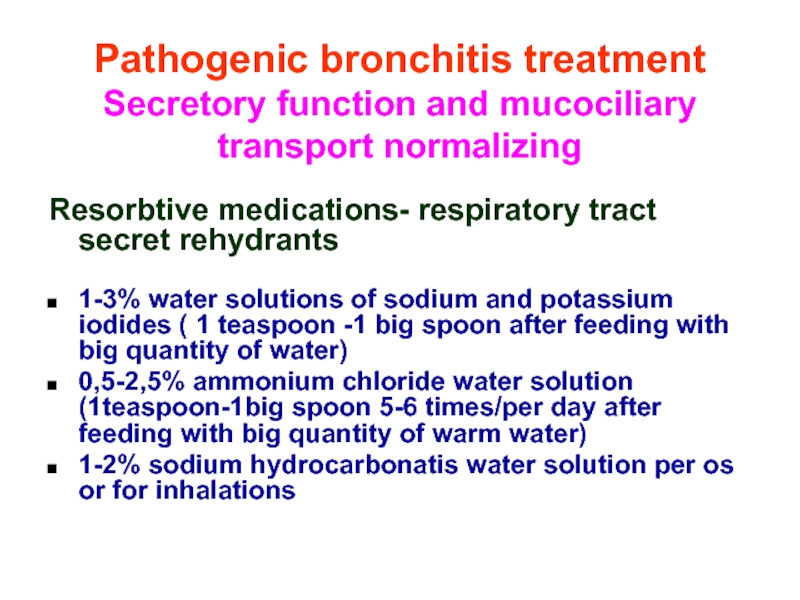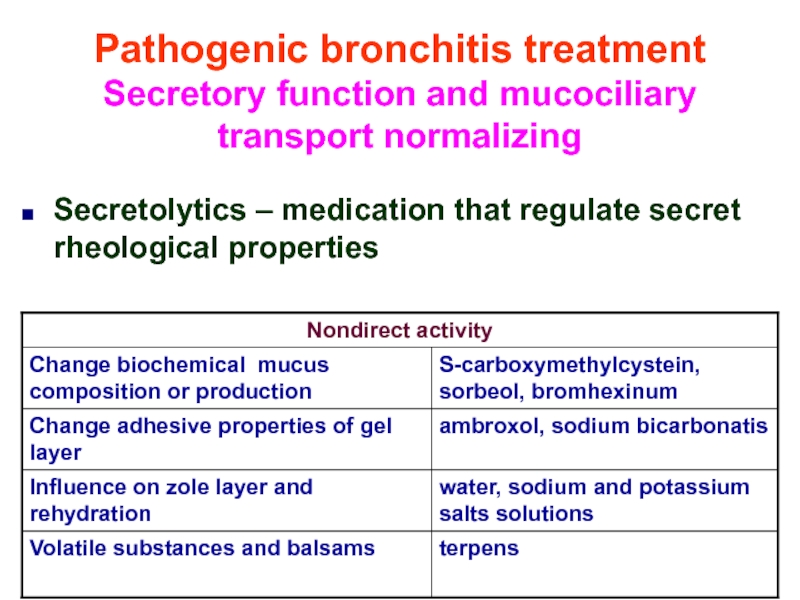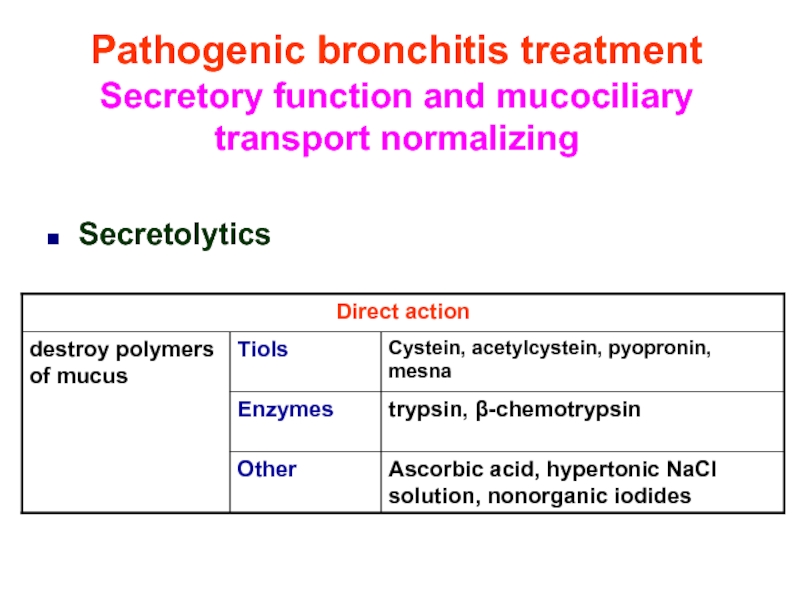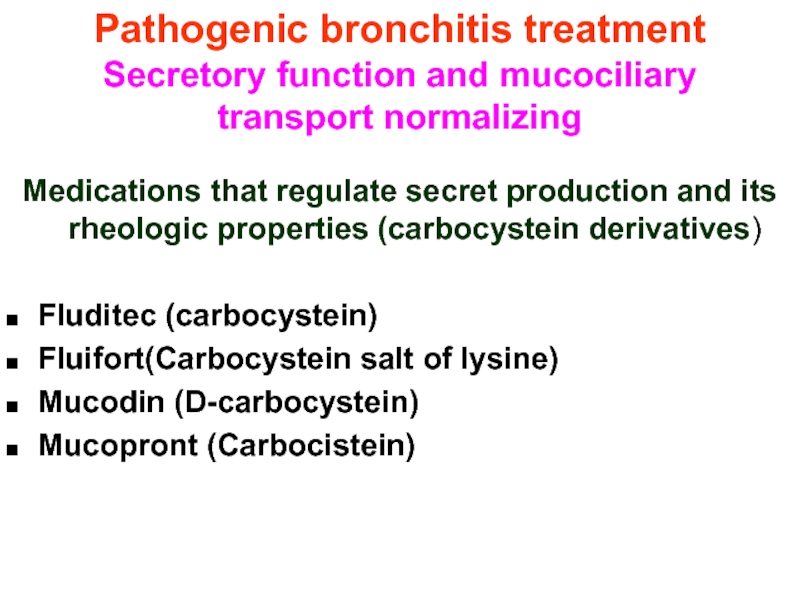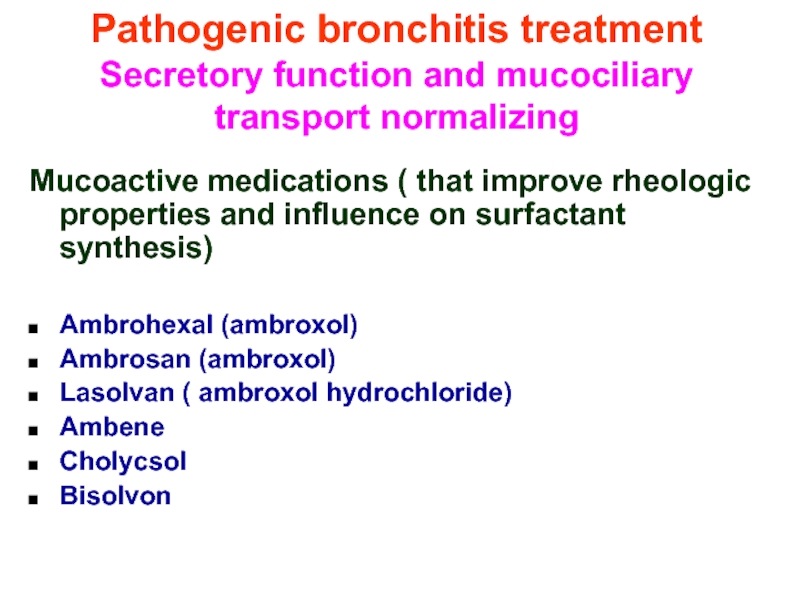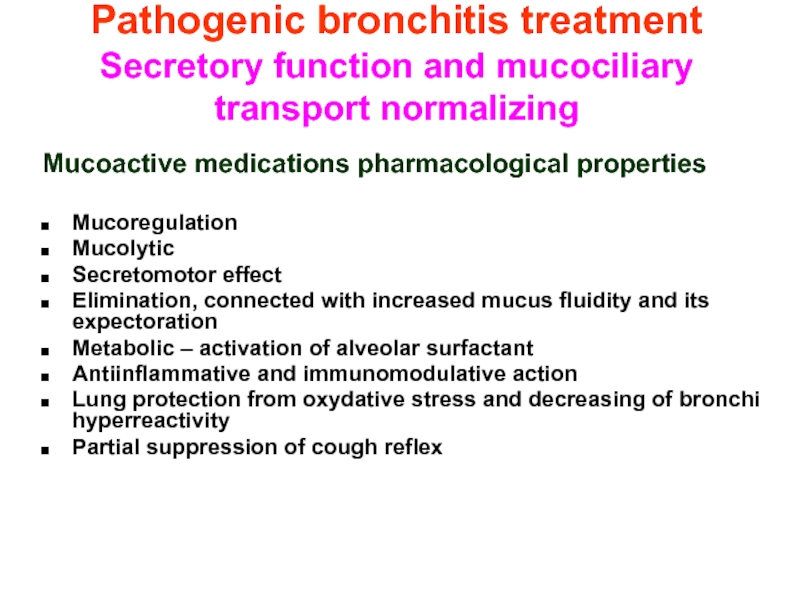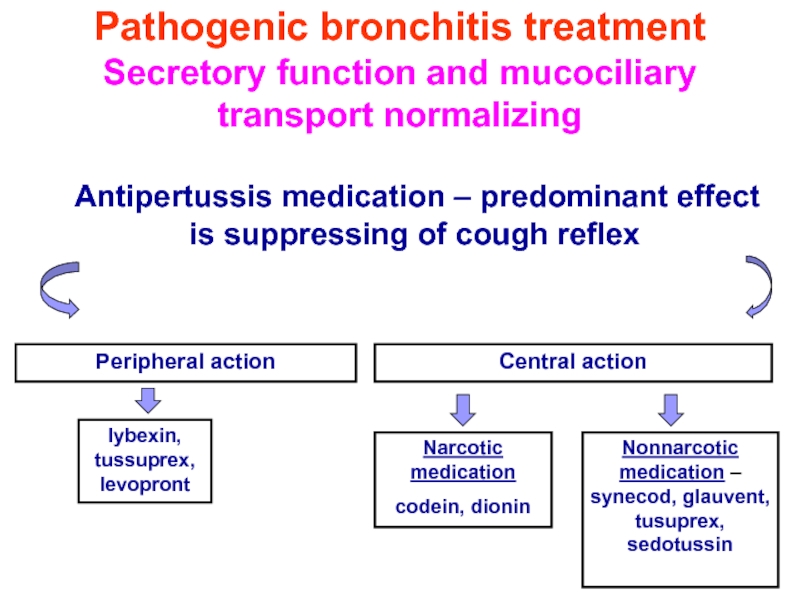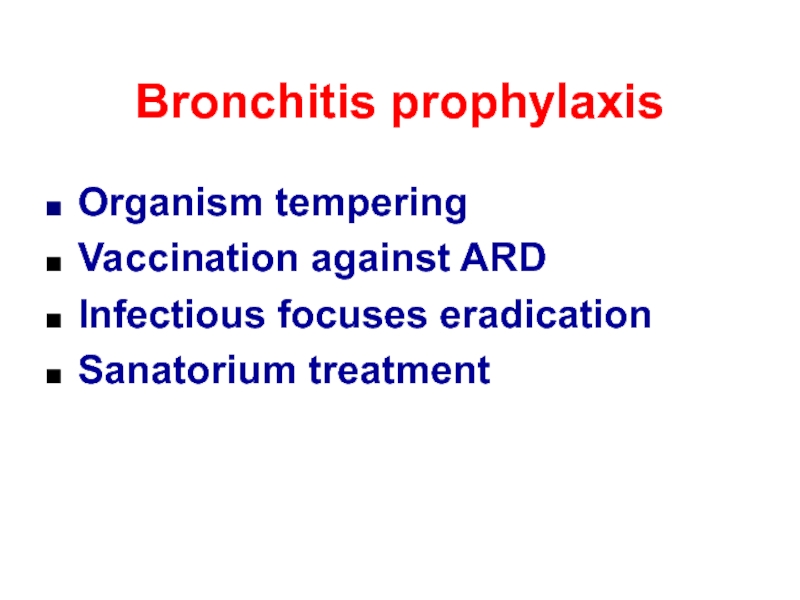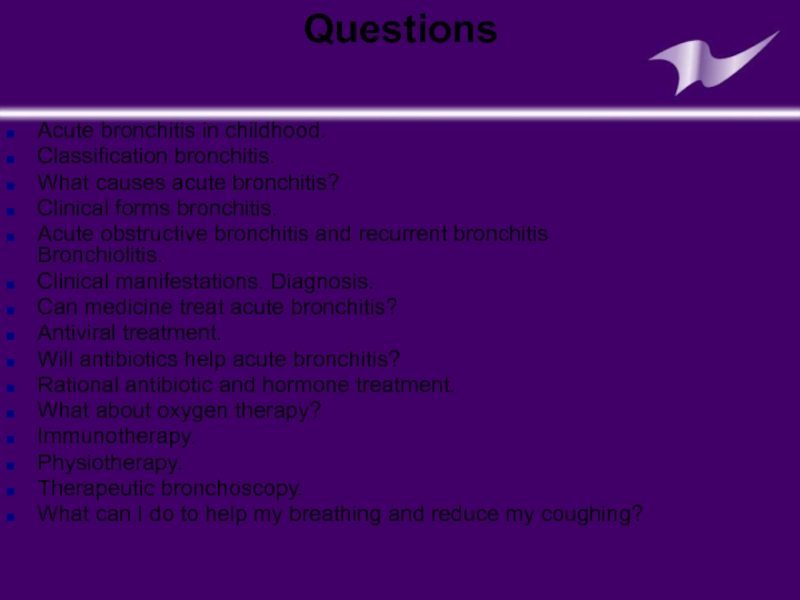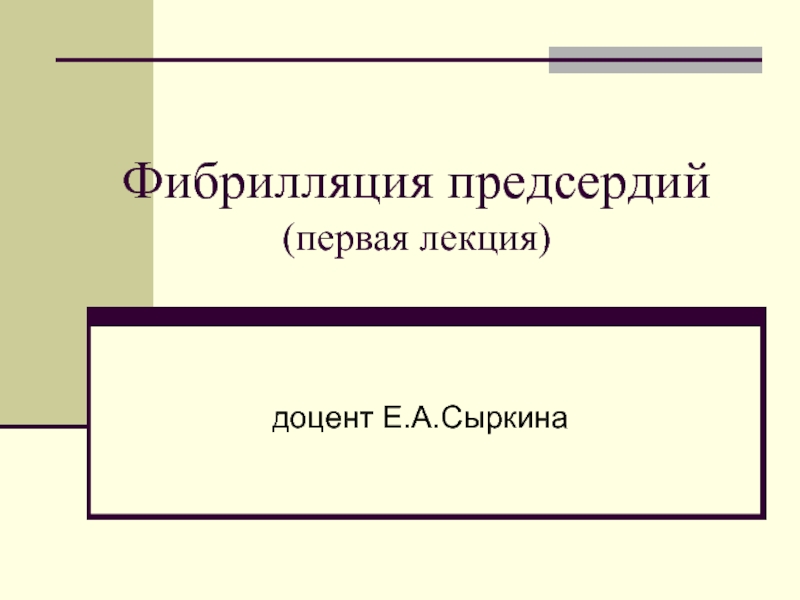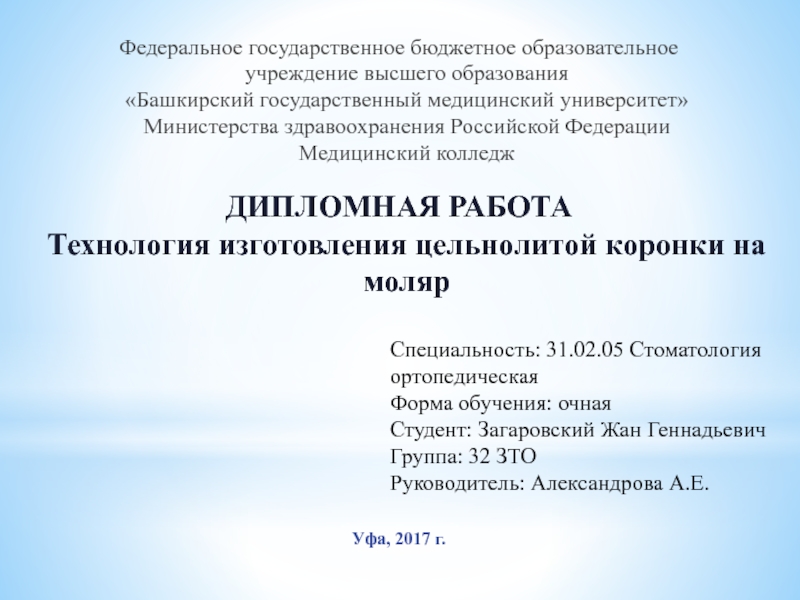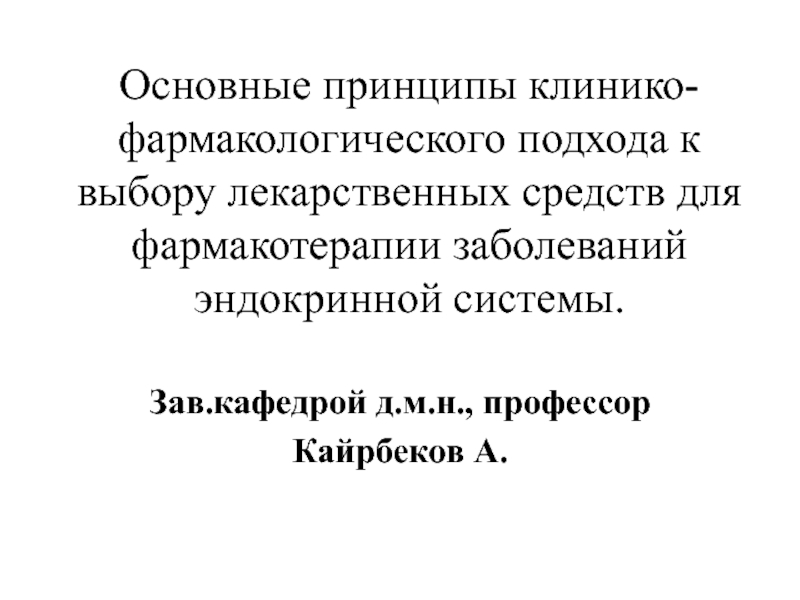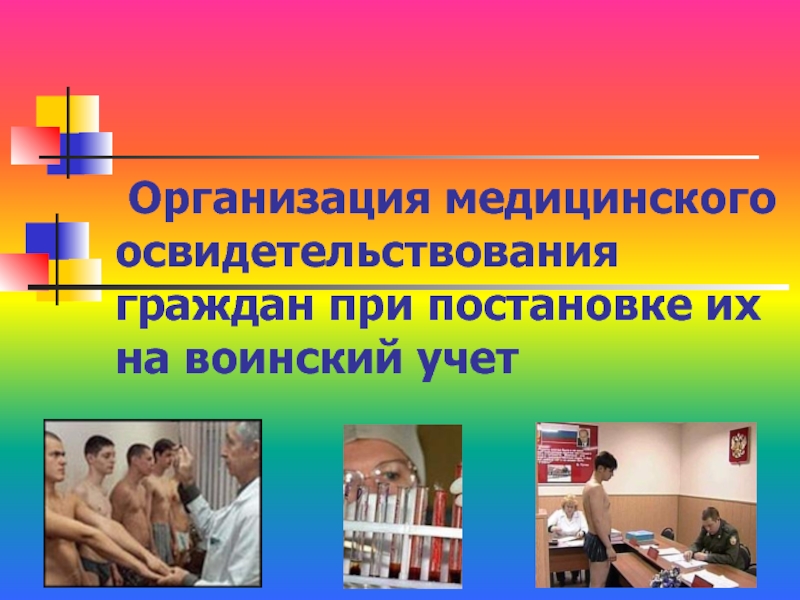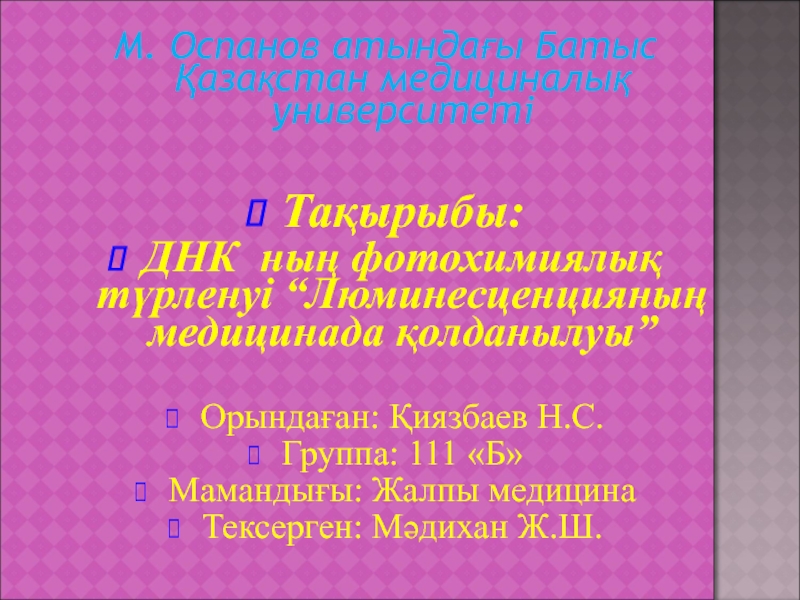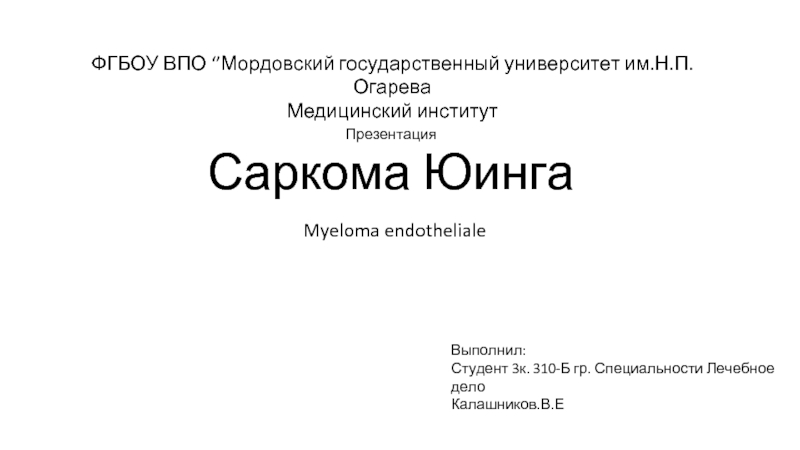- Главная
- Разное
- Дизайн
- Бизнес и предпринимательство
- Аналитика
- Образование
- Развлечения
- Красота и здоровье
- Финансы
- Государство
- Путешествия
- Спорт
- Недвижимость
- Армия
- Графика
- Культурология
- Еда и кулинария
- Лингвистика
- Английский язык
- Астрономия
- Алгебра
- Биология
- География
- Детские презентации
- Информатика
- История
- Литература
- Маркетинг
- Математика
- Медицина
- Менеджмент
- Музыка
- МХК
- Немецкий язык
- ОБЖ
- Обществознание
- Окружающий мир
- Педагогика
- Русский язык
- Технология
- Физика
- Философия
- Химия
- Шаблоны, картинки для презентаций
- Экология
- Экономика
- Юриспруденция
Bronchitis in children презентация
Содержание
- 1. Bronchitis in children
- 2. Plan of the lecture 1. Definition bronchitis
- 3. Bronchitis is an inflammatory disease of bronchi
- 4. Problem is actual due to - Frequent
- 5. Predisposing factors - Nose congestion ( due
- 6. Etiology There are 3 groups Infectious
- 7. Infectious bronchitis Viral –typical for predominant
- 8. Bacterial bronchitis are usually complications of viral
- 9. Bronchitis pathogenesis Etiologic factor Phagocyte migration,
- 10. Mucous membrane Nonspecific
- 11. 1.Pathologic microorganisms damage local tissues and stimulate
- 12. 2. Microorganisms release toxins, stimulate neutrophils’ permeability
- 13. 3. Antibodies are special proteins that can
- 14. 4. Neutrophils create pseudopodias and absorb pathogens
- 15. 5. Microorganisms are destroyed. Remnants of pathogens
- 16. Changes of bronchi in bronchitis These
- 17. Bronchitis diagnostics All clinical symptoms can be
- 18. Cough is a “guard dog of bronchi”
- 19. Any inflammatory process in respiratory tract impairs
- 20. Clinic groups of bronchitis in children Pathogenesis
- 21. Clinic groups of bronchitis in children Course
- 22. Tracheitis(J 04.1) Trachea mucous membrane inflammation
- 23. Acute simple bronchitis ( J 20- J
- 24. Obstructive bronchitis (J 20) Special clinic
- 25. Factors of bronchial asthma development Recurrent obstruction
- 26. Bronchiolitis ( J-21 – J 21.9)
- 27. Chronic bronchitis (J 40-J 42) Disease
- 28. Bronchitis treatment Indications for hospitalization Severe course
- 29. Bronchitis treatment Regimen: special regimen isn’t necessary
- 30. Etiotropic treatment in bronchitis 1.Antiviral treatment
- 31. Etiotropic bronchitis treatment Antiviral treatment Medications Remantadin
- 32. Etiotropic bronchitis treatment Antiviral treatment Interferons Human
- 33. Etiotropic bronchitis treatment 2. Antibacterial treatment
- 34. Etiotropic bronchitis treatment 2. Antibacterial treatment
- 35. Etiotropic bronchitis treatment 2. Antibacterial treatment Medications
- 36. Pathogenic bronchitis treatment Principles of treatment
- 37. Pathogenic bronchitis treatment Antiinflammatory treatment Erespal
- 38. Pathogenic bronchitis treatment Secretory function and mucociliary
- 39. Pathogenic bronchitis treatment Secretory function and mucociliary
- 40. Pathogenic bronchitis treatment Secretory function and mucociliary
- 41. Pathogenic bronchitis treatment Secretory function and mucociliary
- 42. Pathogenic bronchitis treatment Secretory function and mucociliary transport normalizing Secretolytics
- 43. Pathogenic bronchitis treatment Secretory function and mucociliary
- 44. Pathogenic bronchitis treatment Secretory function and mucociliary
- 45. Pathogenic bronchitis treatment Secretory function and mucociliary
- 46. Pathogenic bronchitis treatment Secretory function and mucociliary
- 47. Bronchitis prophylaxis Organism tempering Vaccination against ARD Infectious focuses eradication Sanatorium treatment
- 48. Questions Acute bronchitis in
Слайд 2Plan of the lecture
1. Definition bronchitis
2. Etiology
3. Bronchitis pathogenesis
4. Clinic groups
5. Bronchitis treatment
Слайд 3Bronchitis is an inflammatory disease of bronchi mucous membrane with clinical
Слайд 4Problem is actual due to
- Frequent morbidity
-Frequent complication of pneumonia
-Tendency for
-Predisposing for atopic reactions with further formation of obstructive forms, bronchial asthma
-High financial demands for treatment
Слайд 5Predisposing factors
- Nose congestion ( due to narrowing of nose ways,
Focuses of infection in upper respiratory tract ( rhinitis, sinusitis, tonsillitis)
Immune response abnormality ( immaturity of immune system in infants and toddlers
Co-morbidities (allergic rhinitis, sinusitis, laryngitis)
Passive and early active smoking, toxicomania
Carriage of provisional microflora in respiratory tract
Unfavourable weather ( high humidity,, deviations in surrounding temperature etc)
Слайд 6Etiology
There are 3 groups
Infectious bronchitis ( viruses, bacteria, atypical microorganisms, fungus,
Noninfectious, due to influence of various allergens, toxic substances, physical factors on mucous membrane
Mixed etiology influence of infectious factors as well noninfectious
Слайд 7Infectious bronchitis
Viral –typical for predominant acute and recurrent forms of disease
Слайд 8Bacterial bronchitis are usually complications of viral process in respiratory tract
The
( data of Geraschenko T.I., 2002)
The most significant are Candida, Aspergillus among fungus infection
Слайд 9Bronchitis pathogenesis
Etiologic factor
Phagocyte migration, proinflammatory mediators releasing (cytokines, enzymes), their
Respiratory tract mucous membrane
direct impairment
Vessel reaction
Vasodilation
Increased permeability of vessel wall
Exudation
Mucous membrane edema
Bronchial hypersecretion
due to irritation and dilation of goblet cells
Слайд 10
Mucous membrane
Nonspecific immune response in bronchitis
Prostaglandins
Neutrophils
MIcroorganisms
1.
2.
3.
5.
4.
Blood vessel
Neutrophil
Antibodies
Receptor
Lyzosomes
Neutrophil catch microorganism
Microorganism eradication
Destroyed microorganism
Слайд 111.Pathologic microorganisms damage local tissues and stimulate releasing of prostglandins and
Bronchi mucous membrane
Простагландины
Микроорганизмы
Нейтрофилы
Слайд 122. Microorganisms release toxins, stimulate neutrophils’ permeability from circulation (neutrophils by
Blood vessesl
Neutrophil
Слайд 133. Antibodies are special proteins that can attach to microorganisms. New
Antibody
Receptor
Слайд 144. Neutrophils create pseudopodias and absorb pathogens by this structures. Digestion
Lyzosome
Neutrophil captures microorganism
Слайд 155. Microorganisms are destroyed. Remnants of pathogens can be excreted on
Microorganism eradication
Destroyed microorganism
Слайд 16Changes of bronchi in bronchitis
These are pictures of healthy normal
1
2
Слайд 17Bronchitis diagnostics
All clinical symptoms can be divided for
Main constant ( cough,
Additional, transient ( rales, obstructive syndrome, dyspnea)
Слайд 18Cough is a “guard dog of bronchi”
Complex reflectory mechanism that protects
Слайд 19Any inflammatory process in respiratory tract impairs mucociliar clearance due to
Partial
Impairment of secret moving
Secret layer increasing
Raising secret viscosity
Secret accumulation in various parts of respiratory tract
Слайд 20Clinic groups of bronchitis in children
Pathogenesis
Primary
Secondary
Etiology
Infectious
Viruses
Bacterial
Mixed ( viral, bacterial)
Fungus
Noninfectious
Allergic factors
Chemical factors
Physical
Smoke
Mixed
due to infectious and noninfectious factors
Слайд 21Clinic groups of bronchitis in children
Course
Acute (not more than 2-3 weeks)
Lingering
Recurrent ( repeat more than 3 times per year, phase of exacerbation and remission)
Clinic type
Simple ( nonobstructive)
Obstructive
Affected level
Tracheitis
Tracheobronchitis
Bronchitis
Bronchiolitis
Слайд 22Tracheitis(J 04.1)
Trachea mucous membrane inflammation as a result of acute respiratory
Disease can be accompanied by inflammation of larynx (Laryngotracheitis, J 04.2) or in bronchi ( Tracheobronchitis, J 20)
Слайд 23Acute simple bronchitis ( J 20- J 20.9)
Acute bronchial mucous membrane
Symptoms of viral intoxication: common condition impairment, chills, decreased appetitie, behavioral changes of child, flaccidity, weakness or excitability, impairment of sleeping, fever, head ache, transient muscle pains, catarrhal events in nasopharynx
Symptoms of bronchitis: cough, sputum production, formation of rales, dyspnea
Physical examining: percussion and palpation without changes
Auscultative changes: rough bronchial sound, prolonged expiration, bilateral rales in various parts of lungs changes after cough
Hemogram changes: elevated ESR while normal or decreased leucocyte count
Chest X-ray: enhancing of bronchial linearity, root shadow is wide, not clear
Слайд 24Obstructive bronchitis (J 20)
Special clinic type of disease with bronchial obstructive
Diagnostic criteria
Common condition impairment, rhinitis symptoms, nasopharyngitis, catarrhal symptoms
Body temperature normal sometimes subfebrile, rarely hyperthermia
Manifested respiratory failure
Signs of bronchial patency abnormality
During percussion: tympanic sound
Auscultation – rough bronchial sound, prolonged expiratory sound, moist bubbling rales, during expiration dry whistling (wheezing) rales
Manifested tachycardia
X-ray picture - intensification of vascular picture, increased clearance of lungs due to emphysema, amplification of bronchial picture
Слайд 25Factors of bronchial asthma development
Recurrent obstruction ( three and more episodes
Atopy inheritance
Obstruction is initiated by contact with allergens of noninfectious nature
Proved dust, epidermal and other types of sensibilization
Co-morbidities: another allergic diseases like atopic dermatitis, allergic rhinitis, conjunctivitis
IgE level I blood is more than 100IU/l
Bronchoscopic picture in obstructive bronchitis; in aperture of left main bronchus solid sputum clot is visualised
Слайд 26Bronchiolitis ( J-21 – J 21.9)
Acute generalized obstructive disease of distal
Disease develops only in infants
Clinical peculiarities of bronchiolitis
Progressive dyspnea
Nonproductive cough
Manifested signs of severe bronchoobstructive syndrome
Signs of respiratory failure
Another organs and systems reactions (cardiovascular syndrome, hypoxic changes of CNS)
Percussion tympanic resonance
Auscultation bilateral manifested respiratory sound attenuation, expiratory sound isn’t audible. In basal part of lung crepitation or bubbling sound on the ground of attenuated breathing sound, special “inspiratory” peep is audible
Слайд 27Chronic bronchitis (J 40-J 42)
Disease is characterized by episodic or constant
Diagnostic criteria of chronic bronchitis in children
Prolonged pulmonologic anamnesis
Stable clinic signs, impaired tolerance of physical loadings, changed shape or deformities of chest, thickening of distal phalangs and nails
Stable (local or spread) physical changes in lungs
Radiologic signs “Solidified” X-ray picture with emphysema signs, pneumofibrosis, manifested deformity of lung picture
Deformity of bronchi
Stable, sometimes progressive respiratory function impairment
Слайд 28Bronchitis treatment
Indications for hospitalization
Severe course of bacterial bronchitis, manifested signs of
Complicated bronchitis – with manifested mucus retention, impaired bronchial patency, atelectasis formation etc.
Bronchiolitis ( in children of less than 1 y.o. because of threatening of emergency conditions)
Severe types of Obstructive bronchitis (OB) – especially resistant for treatment in ambulatory conditions
Lingering and recurrent bronchitis ( for diagnostic and treatment)
Chronic forms of disease ( for treatment and full examining)
Bronchitis on the ground of another somatic severe diseases ( CNS, anomalies and malformations of organs chronic disorders
Social reasons
Слайд 29Bronchitis treatment
Regimen: special regimen isn’t necessary but more proper home regimen
Diet: must be rational rich in vitamins
Medical treatment:
Etiotropic
Pathogenic
Слайд 30Etiotropic treatment in bronchitis
1.Antiviral treatment
Indications for antiviral medication:
In moderate and
In children with respiratory support
For bronchitis prevention in group of frequently and severe ill children
For prophylaxis and treatment of premature children
In complex treatment of recurrent bronchitis
For prophylaxis of chronic bronchitis exacerbations
Слайд 31Etiotropic bronchitis treatment
Antiviral treatment
Medications
Remantadin
Algirem
Arbidol
Amixin
Ribavirin
Tamiflu (ozeltamivir)
Aflubin
Слайд 32Etiotropic bronchitis treatment
Antiviral treatment
Interferons
Human Leucocyte Interferone (IFN-alfa)
Reaferon (recombinant alfa-IFN)
Viferon
Gripferon
Inductors of Interferons
Cycloferon
Neovir
Poludan
Слайд 33Etiotropic bronchitis treatment
2. Antibacterial treatment
Indications for prescribing antibacterial treatment
Fever (T> 38C
Intoxication signs
Purulent sputum production together with intoxication
Presence of chronic focus of infection together with bronchitis (purulent otitis, rhinitis, sinusitis, lymphadenitis etc)
Lingering ( more than 2 weeks) or recurrent course of disease
Premature child or infants of first 6 mo old with law indexes of health
Unfavourable premorbid phone of disease
Chronic bronchitis exacerbations with clinic indexes of bacterial infections
Hospital bronchitis
Слайд 34Etiotropic bronchitis treatment
2. Antibacterial treatment
Antibiotic treatment approach
Choice of start antibiotic
Choice of
Choice of effective antibiotic is performed empirically taking into account more probable causative factor according to site of infection (community acquired, hospital), patient age, premorbid phone, severity of bacterial process
Слайд 35Etiotropic bronchitis treatment
2. Antibacterial treatment
Medications of choice
Aminopenicillines with β –lactamase inhibitors
Cephalosporines I-III generations ( cephazoline, cefalexin, Cefaclor, cefuroxim, cefotaxim, ceftriaxone)
Macrolides ( azitromycine, clarythromycine) alternative medications ( in case of β-lactams antibiotic intolerance)
In case of local inflammative process ( laryngotracheitis, tracheitis, tracheobronchitis) – topical antibiotic (bioparox-fuzenzhin)
Слайд 36Pathogenic bronchitis treatment
Principles of treatment
Respiratory tract mucous membrane inflammation suppression
Normalization of
Control of cough reflex
Restoration of bronchial patency (bronchial obstruction elimination)
Слайд 37Pathogenic bronchitis treatment
Antiinflammatory treatment
Erespal ( Fenspirid) – perform multiple action on
Effects of Erespal
Influence of vessel and cell components of inflammation that decrease permeability of vessels exudation and edema
Partial blockage of α-adrenoreceptors that decrease hypersecretion of sputum
Influence of bronchial patency due to spasmolytic action on smooth muscles and improvement of mucociliar clearance
Antagonist activity o H-1 hystamine receptors, decreasing synthesis and inhibition action of hystamine
Decreasing of leucocyte infiltration
Nondirect influence for cough intensity
Слайд 38Pathogenic bronchitis treatment
Secretory function and mucociliary transport normalizing
All medications that
Mucokinetics or expectorant
Respiratory tract secret rehydrant medication
Mucolytics or medications that directly influence on secret rheologic properties
Mucoregulators
Medications that stimulate lung surfactant production
Antipertussis medication
Слайд 39Pathogenic bronchitis treatment
Secretory function and mucociliary transport normalizing
Mucokinetics – expectorant (secret-motor)
Mucaltin
Bronchicum
Tussin
Слайд 40Pathogenic bronchitis treatment
Secretory function and mucociliary transport normalizing
Resorbtive medications- respiratory tract
1-3% water solutions of sodium and potassium iodides ( 1 teaspoon -1 big spoon after feeding with big quantity of water)
0,5-2,5% ammonium chloride water solution (1teaspoon-1big spoon 5-6 times/per day after feeding with big quantity of warm water)
1-2% sodium hydrocarbonatis water solution per os or for inhalations
Слайд 41Pathogenic bronchitis treatment
Secretory function and mucociliary transport normalizing
Secretolytics – medication that
Слайд 42Pathogenic bronchitis treatment
Secretory function and mucociliary transport normalizing
Secretolytics
Слайд 43Pathogenic bronchitis treatment
Secretory function and mucociliary transport normalizing
Medications that regulate secret
Fluditec (carbocystein)
Fluifort(Carbocystein salt of lysine)
Mucodin (D-carbocystein)
Mucopront (Carbocistein)
Слайд 44Pathogenic bronchitis treatment
Secretory function and mucociliary transport normalizing
Mucoactive medications ( that
Ambrohexal (ambroxol)
Ambrosan (ambroxol)
Lasolvan ( ambroxol hydrochloride)
Ambene
Cholycsol
Bisolvon
Слайд 45Pathogenic bronchitis treatment
Secretory function and mucociliary transport normalizing
Mucoactive medications pharmacological properties
Mucoregulation
Mucolytic
Secretomotor
Elimination, connected with increased mucus fluidity and its expectoration
Metabolic – activation of alveolar surfactant
Antiinflammative and immunomodulative action
Lung protection from oxydative stress and decreasing of bronchi hyperreactivity
Partial suppression of cough reflex
Слайд 46Pathogenic bronchitis treatment
Secretory function and mucociliary transport normalizing
Antipertussis medication
Peripheral action
Central action
lybexin, tussuprex, levopront
Narcotic medication
codein, dionin
Nonnarcotic medication – synecod, glauvent, tusuprex, sedotussin
Слайд 47Bronchitis prophylaxis
Organism tempering
Vaccination against ARD
Infectious focuses eradication
Sanatorium treatment
Слайд 48
Questions
Acute bronchitis in childhood.
Classification bronchitis.
What causes acute bronchitis?
Clinical
Acute obstructive bronchitis and recurrent bronchitis Bronchiolitis.
Clinical manifestations. Diagnosis.
Can medicine treat acute bronchitis?
Antiviral treatment.
Will antibiotics help acute bronchitis?
Rational antibiotic and hormone treatment.
What about oxygen therapy?
Immunotherapy.
Physiotherapy.
Therapeutic bronchoscopy.
What can I do to help my breathing and reduce my coughing?
